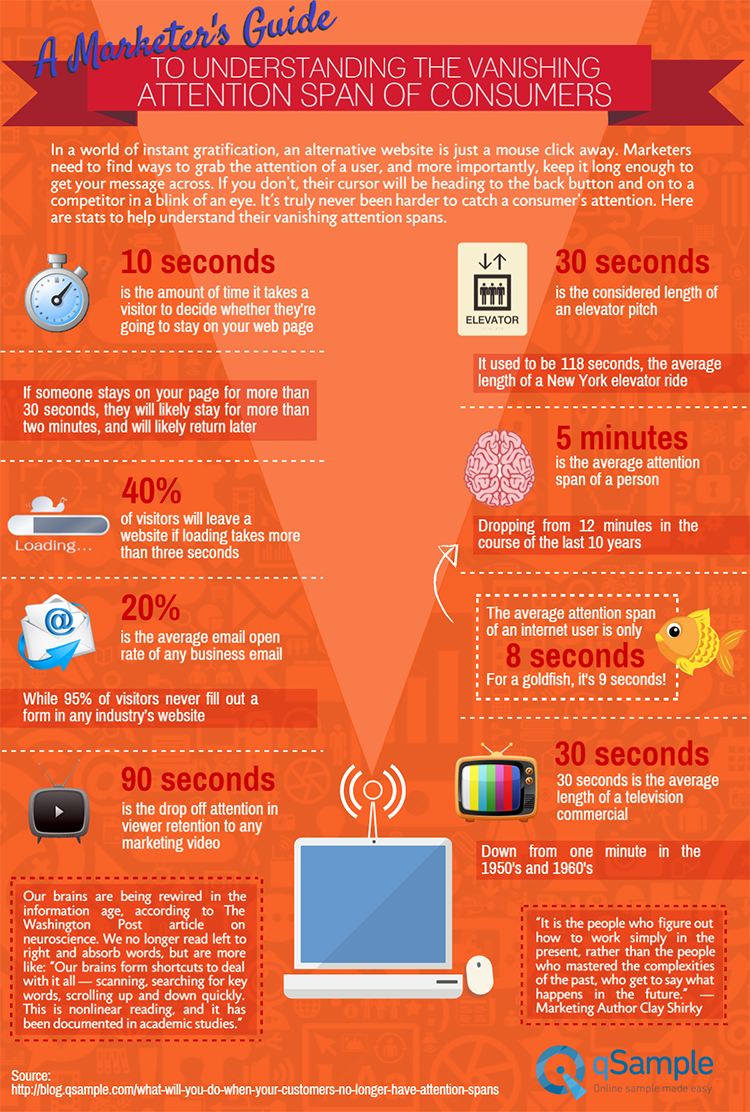It’s no secret that multiple mediums have given consumers a vast amount of choices – and no one has yet discovered more minutes in the day.
It’s no secret that competition in a soft economy is stiffer than a Pan Galactic Gargle Blaster with Red Bull (for those familiar with The Hitchhiker’s Guide to the Galaxy).
It’s no secret the world has shrunk with information, but that same information has shrunk our attention spans.
What is a secret, though, is the unbelievable levels of attention spans have declined during the Digital Age.
It’s far more than many of us would like to face.
That is what this week’s infographic deals is based on our article What Will You Do When Your Customers No Longer Have Attention Spans? The article does offer some solutions for marketers, but until we accept there is an issue…wait…what was I saying?
Never mind. Please enjoy the infographic, and I hope you find the attention to have a lovely day.
Key Highlights from the Infographic
- 10 Seconds: Visitors decide within 10 seconds whether to stay on a webpage.
- Loading Times Matter: 40% of visitors leave if a page takes more than 3 seconds to load.
- Engagement Potential: If users stay beyond 30 seconds, they are likely to stay for 2 minutes or more and may return later.
- Short Attention Spans: The average human attention span is now only 8 seconds, compared to 12 seconds a decade ago.
- Video Drop-off: Most viewers lose interest after 90 seconds in marketing videos.
- Email Challenges: Only 20% of business emails are opened, while 95% of website visitors don’t fill out forms.
- Evolution of Communication: With information overload, people now scan rather than read, searching for key points and ignoring non-essential details.
Understanding the Decline in Consumer Attention Spans
In today’s fast-paced digital landscape, capturing and maintaining consumer attention has become increasingly challenging.
The proliferation of information has led to a significant decline in attention spans. Research shows that the average human attention span has dropped from 12 seconds in 2000 to just 8 seconds in recent years, underscoring the need for marketers to adapt their strategies.
Key Statistics
- Webpage Engagement: Visitors decide within 10 seconds whether to stay on a webpage. 40% of users abandon a site if it takes more than 3 seconds to load.
- Video Content: Marketing videos experience significant viewer drop-off after 90 seconds, emphasizing the importance of concise and engaging content.
- Email Marketing: Only 20% of business emails are opened. A staggering 95% of website visitors do not complete forms.
Strategies to Enhance Consumer Engagement
- Optimize Load Times: Ensure webpages load quickly to minimize bounce rates and retain visitor interest.
- Create Concise Content: Develop short, impactful messages to cater to shorter attention spans.
- Leverage Visual Media: Use images and short videos to grab attention more effectively than plain text.
- Incorporate Interactive Elements: Features like polls, quizzes, and interactive infographics encourage longer engagement.
- Personalize User Experience: Tailor content to individual preferences to enhance relevance and maintain interest.
Conclusion
The decline in attention spans poses a significant challenge for marketers.
However, by acknowledging this reality and implementing strategies such as faster load times, engaging visual content, and personalized experiences, businesses can better capture and retain consumer interest.
In today’s competitive digital environment, adapting to these changes is not optional—it’s essential.
This post was originally published at qSample.
